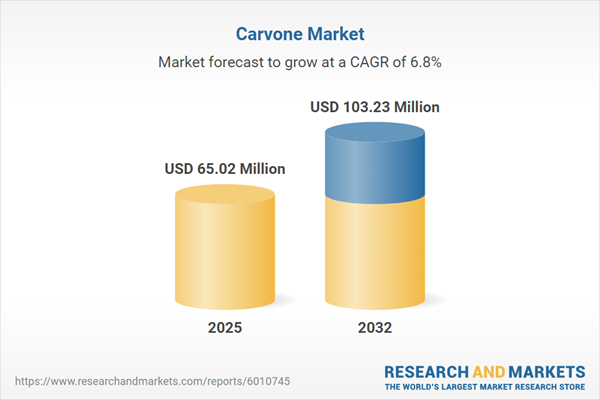Speak directly to the analyst to clarify any post sales queries you may have.
Senior executives navigating the specialty chemicals sector face a rapidly shifting landscape, highlighted by the need for dynamic compliance, supplier diversification, and robust operational performance. In the Carvone market, proactive risk management and process innovation are now crucial levers for securing resilient supply chains and gaining an edge as regulations and consumer expectations evolve.
Market Snapshot: Carvone Market Size and Growth Outlook
The global Carvone market demonstrates steady expansion, with a current valuation of USD 60.94 million and a projected rise to USD 65.02 million within the coming year. Analysis suggests the sector will reach USD 103.23 million by 2032, reflecting an annual compound growth rate of 6.81%. Demand remains strong across manufacturing, agriculture, pharmaceuticals, and food production, where Carvone is leveraged as a valued differentiation tool and compliance enabler. Organizations are increasingly turning to Carvone to strengthen procurement strategies and maintain competitiveness within essential supply networks.
Scope & Segmentation of the Carvone Market
- Applications: Carvone supports process consistency and flexibility across agriculture, cosmetics, food and beverage, fragrance, and pharmaceuticals, making it vital for regulatory adherence and efficiency.
- Agriculture: As a plant growth promoter, herbicide, and pesticide, Carvone aids in stabilizing crop outputs while reinforcing sustainable practices and enabling quick adaptation to new regulations.
- Cosmetics: Central to haircare, skincare, and natural product lines, Carvone gives brands a pathway to meet ingredient transparency demands and integrate with regional compliance standards.
- Food & Beverage: Present in bakery, dairy, beverage, and confectionery applications, Carvone ensures access to traceable, natural ingredients for meeting high market and safety benchmarks.
- Fragrance: Used in soaps, cleaners, and perfumes, Carvone allows companies to tailor products for local markets and meet specific consumer and policy requirements.
- Pharmaceuticals: In oral, topical, and inhalant drug manufacturing, Carvone enables strong supply assurance, emphasizing both purity and compliance in regulated environments.
- Sources: Decisions between natural plant-derived or synthetic Carvone impact sustainability goals, cost management, and stability in ingredient availability.
- Forms: Offered in liquid, emulsion, and powder, Carvone’s multiple physical forms accommodate varied production and formulation needs across sectors.
- End Users: Key users include food manufacturers, pharmaceutical companies, agricultural firms, and personal care brands, all relying on Carvone for operational stability.
- Distribution Channels: Sourcing occurs through a mix of digital and traditional methods, including direct supplier agreements and third-party distributors, ensuring market access and procurement flexibility.
- Regions: The market operates across diverse territories: Americas, Europe, Middle East & Africa, and Asia-Pacific, each shaped by distinct sourcing approaches and regulatory pressures.
Key Takeaways for Decision Makers
- Advances in distillation and extraction technology are aligning Carvone producers with evolving industry norms and compliance demands across major applications.
- Sustained focus on environmental stewardship drives companies to refine sourcing strategies, improving resource traceability and reducing exposure to compliance risk.
- Heightened need for transparent supply chains is redefining supplier management, especially within food and personal care segments where trust and accountability are business imperatives.
- Emphasizing regional partnerships helps organizations mitigate risks associated with cross-border logistics and adapt swiftly to supply chain disruptions.
- Modern procurement and supplier platforms enable faster collaboration and agile response to regulatory updates or shifts in industry standards.
Tariff Impact: Navigating US 2025 Import Changes
New tariffs affecting US imports of flavor and fragrance intermediates are prompting Carvone buyers to revisit their sourcing frameworks. Companies are responding by expanding supplier networks, placing a greater emphasis on domestic procurement, and renegotiating contract structures. These actions are designed to safeguard business continuity against changing import and regulatory conditions.
Methodology & Data Sources
This assessment draws upon direct interviews with supply chain partners, insights from technical formulation specialists, and regulatory authority input. Findings are substantiated through recent technical documentation and sector-specific research, enabling reliable support for procurement and leadership decisions.
Why This Report Matters
- Empowers leaders to effectively manage evolving supply chain complexity, address regulatory developments, and fortify continuity planning throughout the Carvone market.
- Offers actionable intelligence on adopting relevant technologies and integrating sustainable practices for more effective procurement, compliance, and risk mitigation.
- Equips teams with analytical frameworks for adapting compliance routines and responding confidently to the expectations of stakeholders and regulators.
Conclusion
Strategic use of technology and agile supply models enables organizations to meet regulatory challenges and respond to shifting demands in the Carvone market, strengthening operational resilience and readiness for future change.
Additional Product Information:
- Purchase of this report includes 1 year online access with quarterly updates.
- This report can be updated on request. Please contact our Customer Experience team using the Ask a Question widget on our website.
Table of Contents
3. Executive Summary
4. Market Overview
7. Cumulative Impact of Artificial Intelligence 2025
Companies Mentioned
The companies profiled in this Carvone market report include:- Givaudan SA
- International Flavors & Fragrances Inc.
- Firmenich International SA
- Symrise AG
- Takasago International Corporation
- Mane SA
- Sensient Technologies Corporation
- T. Hasegawa Co., Ltd.
- Kalsec, Inc.
- Kemin Industries, Inc.
Table Information
| Report Attribute | Details |
|---|---|
| No. of Pages | 194 |
| Published | October 2025 |
| Forecast Period | 2025 - 2032 |
| Estimated Market Value ( USD | $ 65.02 Million |
| Forecasted Market Value ( USD | $ 103.23 Million |
| Compound Annual Growth Rate | 6.8% |
| Regions Covered | Global |
| No. of Companies Mentioned | 11 |









